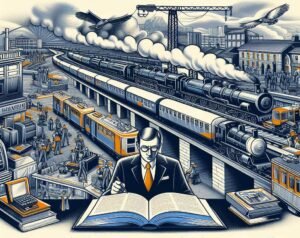by
Marcos Kleber R Felix
What books should I read to better understand the logic of the Brazilian Railway Law?
I had the privilege of participating very closely in the creation of the Brazilian Railway Law, from its embryonic conception to its sanction, going through all stages of discussion in Congress, Executive, and Organized Civil Society. It was a good challenge to advise Brazilian politicians to approve Law No. 14.273, of 2021.
At that time, Brazil had forgotten how to build new railways, how to regulate them, finance them, and encourage them. During this legislative process, we often resorted to empirical foundations, based on observations and real-world experiences, history, facts as they happen and not as they should happen, to argue that the new railway law would attract interested parties.
This article explores the intersection between the Brazilian Railway Law and the real world through seven fundamental literary works. Although at first glance they seem disconnected, these books help to understand the empirical foundations of this new Brazilian law that opens the railway market to private exploration.
Each book offers a unique perspective that, when combined, provides a comprehensive understanding of the empirical principles underlying the Railway Law. These principles are essential for the potential success of the private railway venture in Brazil.
Política e Legislação de Estradas de Ferro (Railway Policy and Legislation)
By Clodomiro Pereira da Silva, this rare work from 1904 offers a profound analysis of railway policy and legislation in Brazil and around the world during the 19th century. Clodomiro provides valuable historical context to understand the evolution of railway laws over the first 80 years of railway enterprises around the world. He criticizes various different approaches to railway regulation and highlights what should and should not be done to promote railway development.
This work clearly shows that the dictates of Law No. 14,273, of 2021, aimed to reopen Brazil to railway investment, in very similar ways to those that prevailed in Brazil until 1904, the golden age of Brazilian railways. The current law, however, incorporates into contemporary legislation the best practices that could not be implemented previously in Brazil, in the time of Clodomiro da Silva. The new adjustments brought in by the new Brazilian Railway law were inspired by the American and Chinese developments in the 19th and 21st centuries, respectively.
The Pursuit of Glory: Europe, 1648–1815
By T. C. W. Blanning, this book, published by Penguin Books in 2007, offers a comprehensive view of European history during a period of significant changes. Although it does not specifically deal with railways, but with navigation canals and toll roads, this work compares the strategy of the British with that of their continental European neighbors.
Blanning provides valuable historical context that helps to understand how political biases can distort a society’s investment priorities. He argues that prioritizing investments by demand is superior to the strategic choices of certain governmental elites. This work offers a broader view to understand how good economic incentives can transform society and the economy, a central theme in the Brazilian Railway Law.
Free to Choose: A Personal Statement
By Milton Friedman and Rose Friedman, this classic work from 1979 defends economic freedom and the free market, which were being threatened by the rise of socialist ideals after World War II. They argue that economic freedom is fundamental to a society’s prosperity. This economic principle was fundamental to the Railway Law, which seeks to promote efficiency through the possibility of competition.
The Friedmans’ main thesis is that a freer market is more capable of choosing the best investment options, and that the State alone tends to make choices that, although well-intentioned, often produce results opposite to their intentions. The Friedmans’ ideas influenced the movement that led the United States to enact the Staggers Rail Act of 1980, which saved American railways from bankruptcy, and also inspires the current Brazilian Railway Law.
Fundamentals of Transportation Systems Analysis
By Marvin L. Manheim. Published around the same time as the previous book, this work provides a solid foundation for the analysis of transportation systems. Manheim offers valuable analytical tools to understand how different components of a transportation system interact.
This knowledge is crucial to understand why the Railway Law allows Brazilian companies to propose railways that best meet their logistical needs. Furthermore, it shows how the integration of logistic chains can make railway enterprises more profitable.
Explaining Railway Reform in China: A Train of Property Rights Re-arrangements
By Linda Tjia Yin-nor. This book provides a positive explanation of the reform in China’s railway sector between 1978 and the dissolution of the Ministry of Railways in 2013. Linda offers insight into how Chinese reforms, which emulated typically capitalist behaviors in bureaucrats managing their state-owned enterprises, could influence the productivity and growth of China’s railways. This aspect is crucial for understanding the Brazilian Railway Law. Here, several successful approaches among Western railways that were put into practice in China are ratified, following Deng Xiaoping’s motto: “It doesn’t matter the color of the cat, as long as it catches mice.”
Financing Transit-Oriented Development with Land Values: Adapting Land Value Capture in Developing Countries
By Hiroaki Suzuki, Jin Murakami, Yu-Hung Hong, and Beth Tamayose. This book explores how land value can be used to finance transit-oriented development. It offers valuable insights that inspired the Brazilian Railway Law to allow railway entrepreneurs to finance their ventures effectively and sustainably, mainly for passenger transport, with land value capture mechanisms and land reajustment. This book is especially important for those who want to develop passenger rail services in Brazil or elsewhere.
Desafios e perspectivas do setor ferroviário brasileiro: novos corredores e a proposta de shortlines (Challenges and Perspectives of the Brazilian Railway Sector: New Corridors and the Proposal of Shortlines)
By João Felipe Rodrigues Lanza and Pedro Daniel Spenciere, from 2022. The only work on the list published after the enactment of the new Brazilian railway framework, this book presents a unique approach to the Brazilian railway market, with a special focus on the proposal of shortlines in Brazil. This is a fundamental point that the Railway Law tried to address through the call for authorization proposals. It is a broad historical study to understand the transformations of the railway system in the country throughout the 20th century, from the perspective of the Austrian school, focused on the proposals presented to expand the railways and diversify railway transport services beyond the logistics of commodities for export.
Again, what books should I read to understand the fundamentals of the Brazilian Railway Law?
Through reading these 7 indispensable books, it is possible to gain a comprehensive understanding of the empirical foundations of Brazil’s Railway Law. Each book offers a unique perspective, addressing different aspects of the transport sector, notably railways.
The history of railways, from their conception to contemporary challenges, is explored in detail in works such as “Railway Policy and Legislation” and “Explaining Railway Reform in China”. These books provide valuable historical context to understand the evolution of railway laws in Brazil, based on international precedents.
In the field of economics, “Free to Choose: A Personal Statement” and “The Pursuit of Glory: Europe, 1648–1815” offer valuable insights into the importance of economic freedom and the free market for the prosperity and efficiency of the railway sector.
In the field of logistics, “Fundamentals of Transportation Systems Analysis” and “Challenges and Perspectives of the Brazilian Railway Sector: New Corridors and the Proposal of Shortlines” provide analytical tools and relevant perspectives to understand how different components of a transport system interact and how public policies can influence the development of the sector.
With regard to railway financing, “Financing Transit-Oriented Development with Land Values: Adapting Land Value Capture in Developing Countries” explores how land value can be used to finance transit-oriented development, offering valuable insights for the practical implementation of the Railway Law.
In summary, reading these books and the practical application of the Brazilian Railway Law can contribute significantly to the evolution of the Brazilian railway sector, promoting efficiency, diversification, and sustainability of railway transport.



